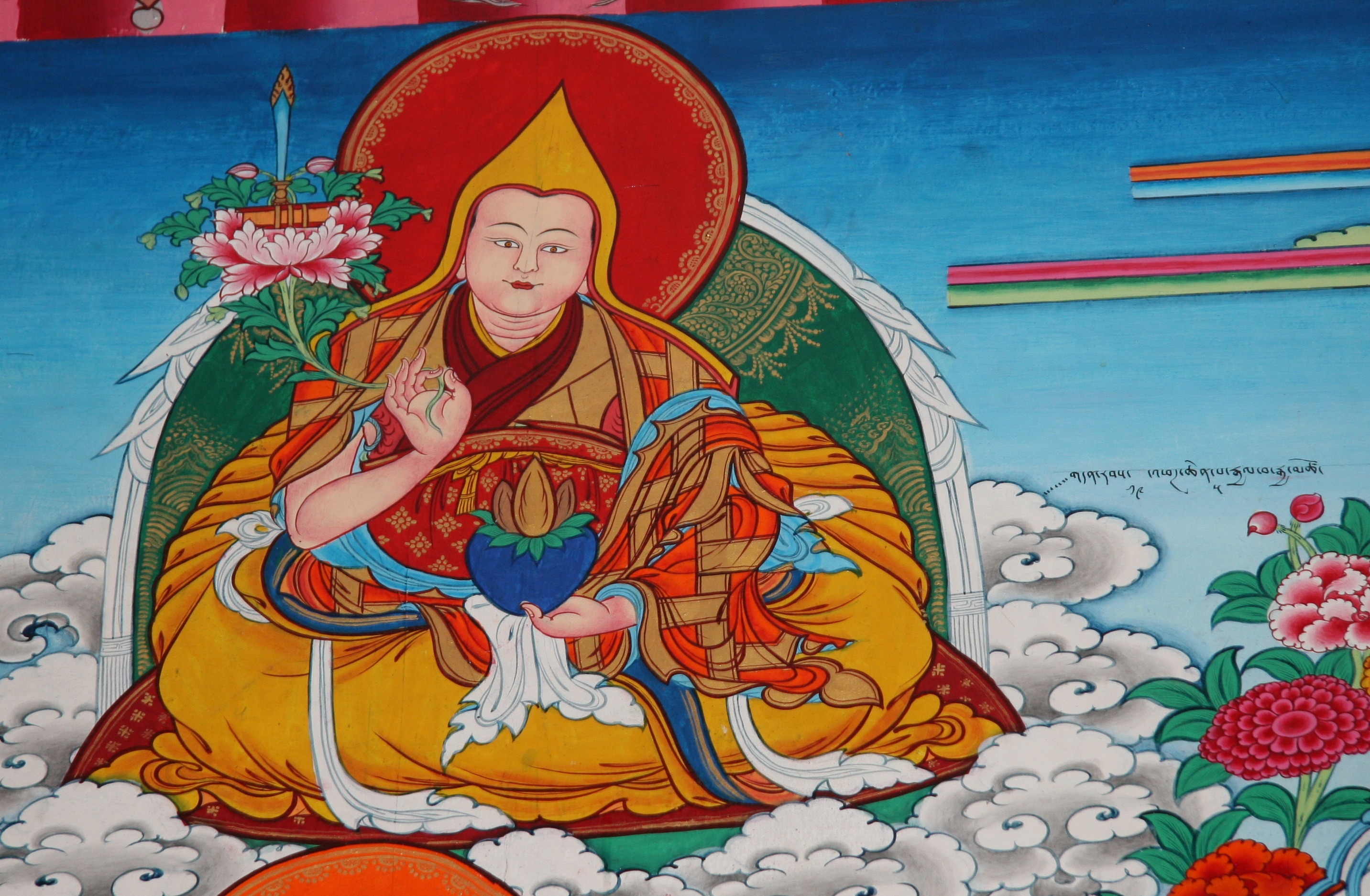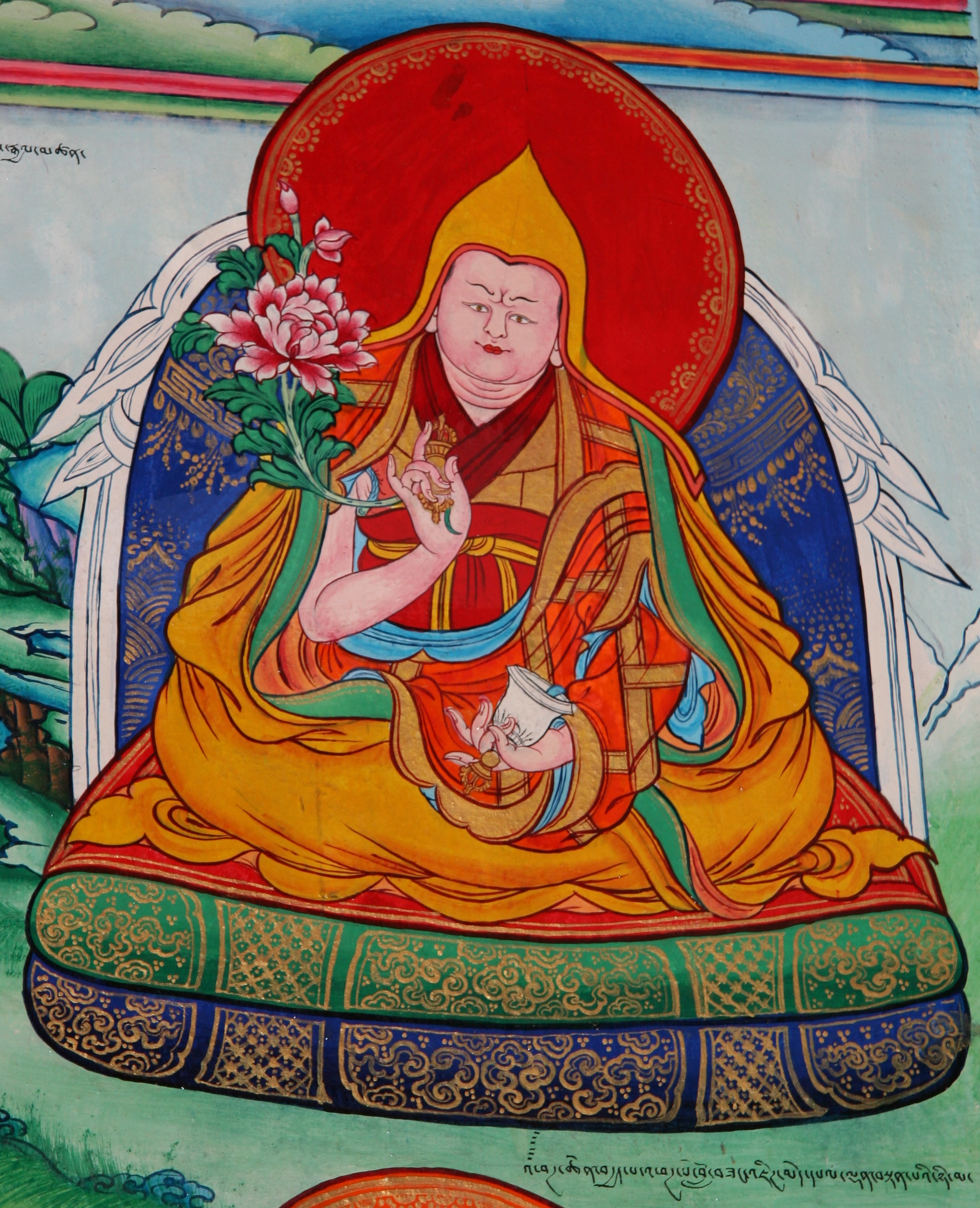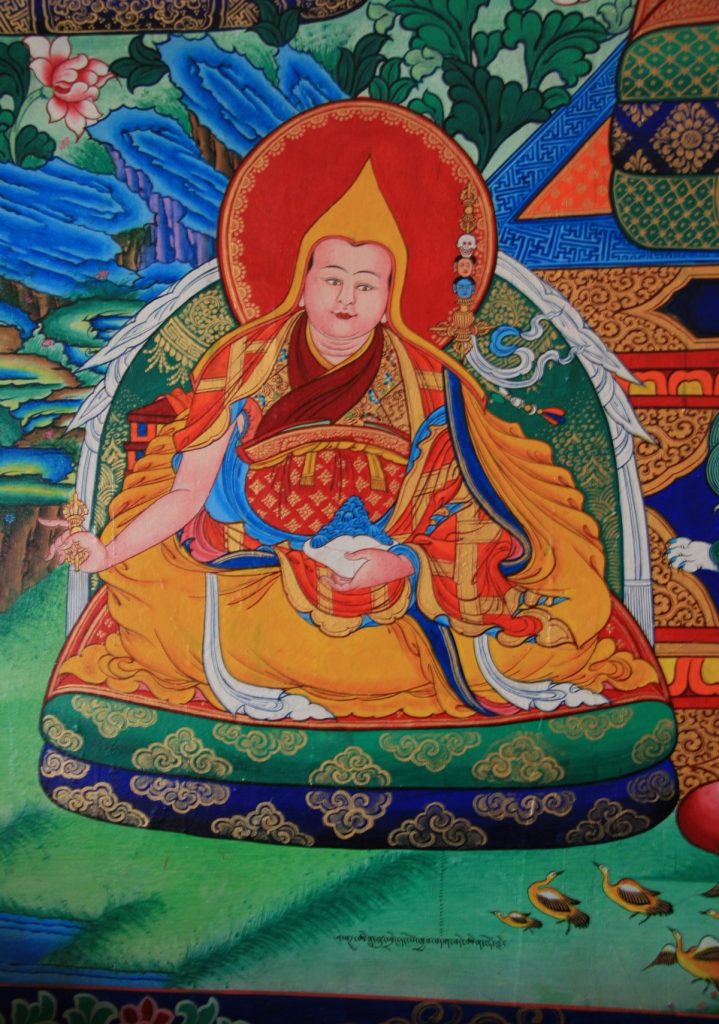The first in the line, Dechen Dorje (1439–1487), the son of a disciple of Tsongkhapa and the grandson of a Bon master, was born in Amdo at the foot of the Nyenchen Tanglha mountain range. He was evidently an extraordinary child: according to legend, the day he was conceived his mother dreamed that the Indian teacher Mitra Yogi (1198–1199) asked her for lodging. He was identified as a reincarnation of Kawa Peltsek, a disciple of the 8th-century saints Padmasambhava and Shantarakshita, and later, at the age of 8, declared himself to be the great Indian Buddhist master Aryadeva (3rd century c.e.), “Pakpa Lha” in Tibetan.
Dechen Dorje is said to have studied under 44 masters in Kham and at Ganden Monastery outside of Lhasa. Later in life, after receiving full ordination, he lived as an itinerant monk, attracting disciples and establishing hermitages and monasteries in various locations in Tibet.
The second Pakpa Lha, Sanggye Pel (1507–1566) declared himself the reincarnation of the first. According to legend, Dechen Dorje commanded his disciples not to search for his reincarnation, saying that he himself would reveal him. This story, along with the fact that Sanggye Pel was only 19 when Dechen Dorje’s disciples officially recognized him, suggests that the identification of the incarnation was contested. The institutions established by Dechen Dorje were looking for a new common leader, and it’s reasonable to surmise that the communities did not all agree on the selection.
 Sanggye Pel studied at Ganden Monastery for several years in his early 20s, taking full ordination at that time. He then traveled to Kham, visiting many of the monasteries his predecessor had founded and establishing new ones.
Sanggye Pel studied at Ganden Monastery for several years in his early 20s, taking full ordination at that time. He then traveled to Kham, visiting many of the monasteries his predecessor had founded and establishing new ones.
Sanggye Pel was present in Litang when the town came under siege by the army of Jang Satam, a kingdom based in present day Lijang, Yunnan, China. Legend has it that when Sanggye Pel tried to put a stop to the battle, a captain of the Jang Satam army threatened him with his sword, only to find himself unable to unsheathe the blade. The captain took this as a sign of the Geluk lama’s power and aborted the entire siege.
Sanggye Pel’s subsequent invitation to the court of the king of Jang Satam was likely the first contact between the kingdom and the Geluk tradition. The importance of this diplomatic connection is indicated by the fact that Sanggye Pel was ordered to remain in Jang by higher-ups in Lhasa such as Gendun Gyatso (1475–1542), posthumously recognized as the Second Dalai Lama.
 Only after several years in Yunnan was Sanggye Pel permitted to travel to Chamdo Jampa Ling at the invitation of the abbot. He spent about three years there ordaining hundreds of monks. Tongwa Donden (1567–1604), Sanggye Pel’s reincarnation and the Third Pakpa Lha, created a lasting relationship between the incarnation line and the monastery by becoming the abbot there in 1594, a position that he held for about ten years.
Only after several years in Yunnan was Sanggye Pel permitted to travel to Chamdo Jampa Ling at the invitation of the abbot. He spent about three years there ordaining hundreds of monks. Tongwa Donden (1567–1604), Sanggye Pel’s reincarnation and the Third Pakpa Lha, created a lasting relationship between the incarnation line and the monastery by becoming the abbot there in 1594, a position that he held for about ten years.
The Fourth Pakpa Lha, Chokyi Gyelpo (1605–1643), also served as the abbot of the monastery. During his service he was involved in the Mongolian invasion of Kham in the 1640s.
By the mid-17th century, the Geluk presence in Chamdo had become a serious threat to the Bon tradition there, and there were a series of clashes. When the Mongolian leader Gushri Khan and his forces swept into Kham on their way to Lhasa, the Bon kingdom of Beri was designated a target—some say due in part to Chokyi Gyelpo’s urging. According to Chamdo histories, following the destruction of Beri, Gushri called a gathering of prominent lamas of Kham and ordered them to obey the Pakpa Lha. Gushri continued on to Lhasa, where he defeated the king of Tsang and helped the Fifth Dalai Lama take control of Tibet.
Some other notable events in the lives of this incarnation line include the Fifth Pakpa Lha, Gyelwa Gyatso (1644–1713) sponsoring an edition of the Kangyur, the Tibetan Buddhist canon. The Sixth Pakpa Lha, Jigme Tenpai Gyatso (1714-1754), continued that work, completing a Tengyur, a collection of the Indian and Tibetan commentaries to the scripture. The Sixth Pakpa Lha was the first to obtain the Chinese Imperial seal and title, a privilege that was enjoyed by successive incarnations. Both the Eighth and Ninth Pakpa Lha incarnations were identified by the Beijing-mandated method of the Golden Urn in Lhasa, evidence that the line was viewed as being of considerable importance by the Chinese court. The Tenth Pakpa Lha oversaw the reconstruction of Chamdo Monastery following its destruction by the Qing general Zhao Erfeng in 1912. He also renounced his vows and took a wife, for which he was stripped of the abbacy of Chamdo and his Imperial titles.
Gelek Namgyel (b. 1940), the current and Eleventh Pakpa Lha, lives in Tibet and is currently serving as the Chairman of the Tibet Autonomous Regional Committee and Vice-Chairman of the 11th Chinese People’s Political Consultative Conference National Committee.
Biography and autobiography in Tibet are important sources for both education and inspiration. Tibetans have kept such meticulous records of their teachers that thousands of names are known and discussed in a wide range of biographical material. All these names, all these lives—it can be a little overwhelming. The authors involved in the Treasury of Lives are currently mining the primary sources to provide English-language biographies of every known religious teacher from Tibet and the Himalaya, all of which are organized for easy searching and browsing.
Thank you for subscribing to Tricycle! As a nonprofit, we depend on readers like you to keep Buddhist teachings and practices widely available.
